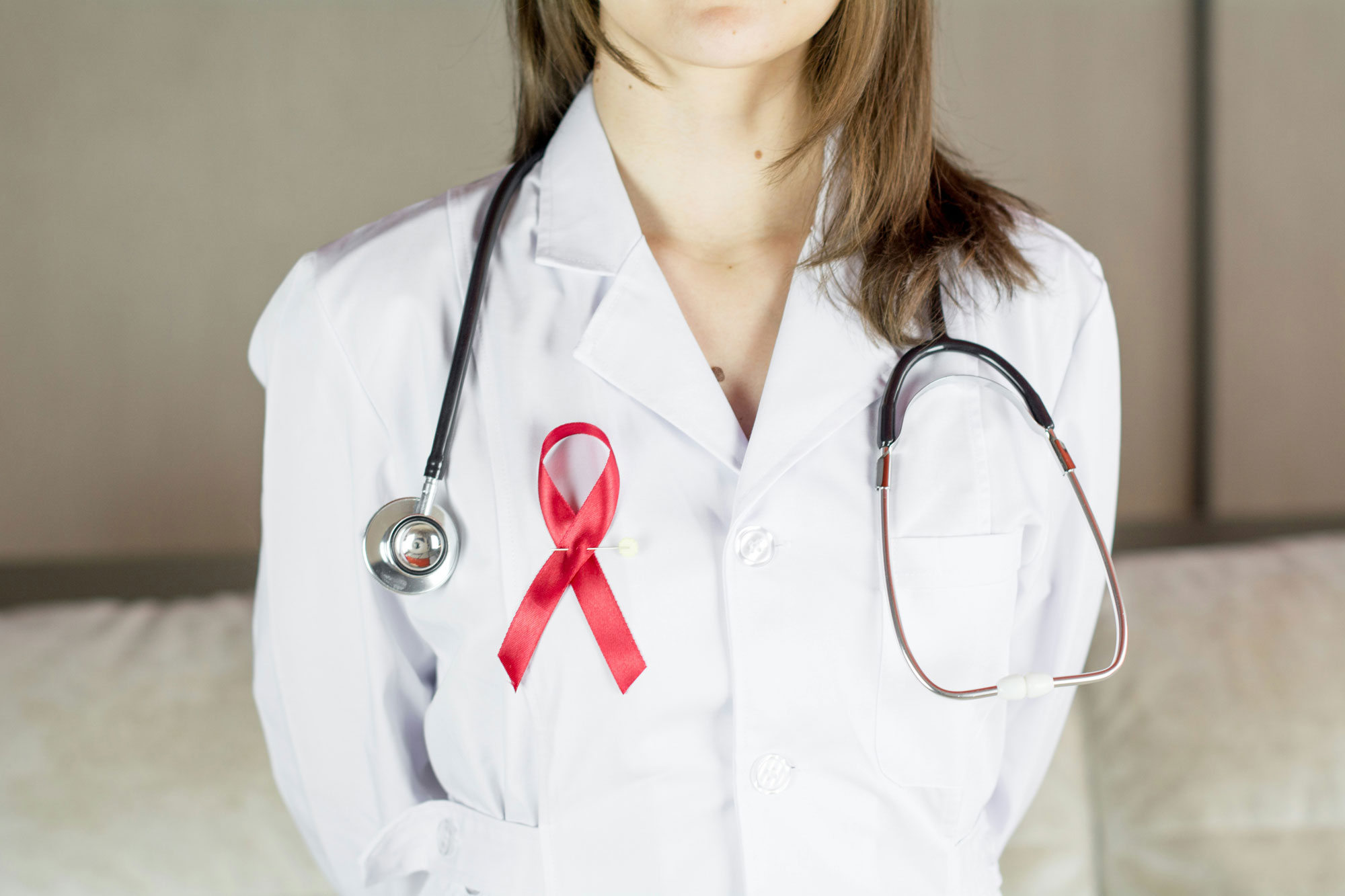Our mental health is inseparably tied to our physical health, life experiences, and social connections. The field of health psychology focuses on the intersection of all of these, examining the relationship between mind and body, the behaviors that keep us healthy, and the unique psychological burdens of illness [1] In the wake of health policy changes that have made people feel more uncertain about their healthcare, especially for those facing highly-stigmatized chronic illnesses like HIV/AIDS, a deeper understanding of the psychological experience of living with HIV can inform approaches for supporting holistic wellbeing for those facing complex illnesses.
In order to have a grasp on the ways a condition like HIV/AIDS impacts mental health, it’s crucial to have some knowledge about what HIV/AIDS is, along with how it is transmitted and treated. HIV (Human Immunodeficiency Virus) is a retrovirus that attacks the immune system’s CD4 T cells, and if left untreated, can lead to AIDS (Acquired Immunodeficiency Syndrome). This is the most severe stage of HIV when the immune system is badly damaged and the lethality of other co-occurring diseases is heightened. HIV is transmitted through contact with certain body fluids such as blood, semen, vaginal fluids, rectal fluids, and breast milk. Transmission is most commonly through unprotected sex, sharing needles, or, less commonly in the US, from an HIV-positive mother to their child during childbirth or breastfeeding [2]. While there is no cure or vaccine, antiretroviral therapy (ART) can effectively control the virus, allowing people with HIV to live long, healthy lives and greatly reduce the risk of transmission. In general, if someone with HIV is able to consistently take ART medications that reduce the amount of virus in the blood (also known as their viral load), their viral load may be reduced enough to where a lab is no longer able to detect it. Fortunately, people living with “undetectable” viral load, who continue their ARTs consistently will not transmit HIV via sex with a HIV-negative partner. Further, options for prevention are available: PrEP (Pre-exposure prophylaxis), used proactively by people at high-risk of infection before a potential exposure, and PEP (Post-exposure Prophylaxis), used within 72 hours after a potential exposure for 28 days following to stop HIV from spreading [3].
Mental health, HIV, and sick roles
Given the social stigma about this condition, fear and alienation can often create a harmful narrative around HIV/AIDS, shaping what sociologists describe as the “sick role” and subsequently the mental health of those living with HIV. In the 1950s, as medical sociology grew as a field, Talcott Parsons sought to understand how illness functioned within a larger social system, describing it as a temporary phase of “sanctioned deviance” from the health and productivity while an individual tries to recover [4]. While Parsons’ initial concept of a sick role was notably limited, assuming that illness is acute and curable and patients adhere entirely to medical authority, it was a starting point for considering the psychosocial experience of disease rather than a purely biomedical one. For someone with an HIV diagnosis, the complex experience of being sick challenges this initial theory. Several barriers, social and systemic, exist. For many reasons, people may face sadness, grief, and anxiety after acquiring HIV/AIDS, which can worsen prior mental health conditions [5]. In the same way the mental health challenges intersect with most diseases, it works cyclically. The burden and isolation from the condition, along with physiological symptoms of it, can harm mental health, while poor mental health simultaneously makes prevention and treatment engagement harder. The contextual factors around HIV acquisition can also play a role. Substance abuse, even beyond injection drug use, and mental health disorders are frequently comorbid for HIV-positive people [6]. Further, if someone acquires HIV after being sexually assaulted, the trauma or physical injury of the event can contribute to additional mental health risk [7]. The downstream effects of this can manifest as poor social support, additional vulnerability to discrimination, and low engagement with healthcare, all of which are barriers to living and thriving with HIV.
Keeping room for hope
While this article is far from a comprehensive review of the mediators through which mental health and HIV/AIDS interact, there are many positive, hopeful elements in the experience of living with HIV/AIDS. Not only are people living within HIV for longer ages due to more effective combinations of antiretroviral treatments, community-focused public health policy, long-acting injectable forms of PrEP. and persistent research efforts, the overall perception of HIV is changing [8]. Previously, the “sick role” was defined by a withdrawal from social duties, but, increasingly, the idea of the empowered patient, through community building and advocacy, creates a more hopeful and proactive vision of someone living and thriving with HIV. Oftentimes a desire for advocacy and representation can be a powerful form of motivation to improve the psychological experiences of others. Malcolm Reid, founder and CEO of Unity Arc Advocacy Group, embodies this, expressing how, “One of the things I want to do with Unity Arc is to put together a group of advocates and speakers who can go out and speak, you know, spread the word about HIV and about health equity, and make a living doing it.” [9] In interviewing him, it was clear that being open and active in community organizing was protective for mental wellbeing, reducing the feeling of being a sitting duck, especially amid recent shifts in HIV/AIDS programming and funding that create a more hostile climate for comprehensive HIV care[10]. Ultimately, as a long-term survivor, the emphasis is on seeing the whole person, rather than their diagnosis: “When I’m talking about HIV and aging, the last thing I think about on a daily basis is HIV.” He continued to describe how “people who find themselves inhibited, stigmatized by their HIV status, trying to hide it, face a whole other mental health challenge while constantly looking over their shoulder,” which gives stigma more power over individual wellbeing. The idea that leaning into community action is adaptive for collective healing is far from anecdotal and has been a growing subject of research to improve clinical outcomes for HIV and other chronic illnesses.
Looking forward: priorities for mental health
Despite a more challenging environment for mental healthcare and healthcare in general amid recent funding cuts, there are several paths forward in strengthening HIV care to be more supportive of whole-person health. For example, resilience-focused interventions and peer support programs are evidence-based methods for improving quality of life for people living with HIV, not just clinical outcomes [11]. As a Person-Centered Care Advocacy Fellow with the International AIDS Society, Annie Potts emphasized how much “people really need spaces where they can talk openly about their issues with other people that get it without having to explain or justify their experiences. Peer support builds community and reduces isolation.” This is at the core of person-centered approaches in psychiatry and mental healthcare, as well: seeing an entire person and their social network as the core of the illness experience, rather than the individual as an isolated clinical unit. By ensuring that providers caring for HIV positive people proactively assess mental health concerns, housing issues, social support, and other determinants of health, treatment plans can be more efficient in addressing multiple aspects of a patient’s concerns at once [12]. Reid underscored the importance of providers in all specialties collaborating to ensure that patients are met where they are, nonjudgmentally. “Whether it be a hangnail or cancer, when people walk into a doctor’s office they’re intimidated” and this intimidation can become a major barrier when dealing with stigmatized conditions: “Especially when you’re talking about HIV or STIs, doctors become accusers. You have the impression that they’ve formulated their diagnosis before they’ve even spoken to the person.” Potts advocates for better training for providers to be more aware of their demeanor and immense influence on the mental health of those they care for. At the same time, she recognizes how compassion fatigue and burnout impacts HIV advocates, stating how “just because we’re helping doesn’t mean we’re immune”, so community check-ins, debriefs, and compassionate supervision in clinical settings can go a long way. All of these perspectives, along with intervention research, emphasize that person-centered mental healthcare is essential, not accessory, to the treatment of any illness, particularly HIV/AIDS. As Reid succinctly put it, “sometimes the most foundational aspects are the things that we ignore the most in mental health.”
Sources:
-
https://www.apa.org/education-career/guide/subfields/health
-
https://hivinfo.nih.gov/understanding-hiv/fact-sheets/stages-hiv-infection
-
https://novusacs.com/prep-vs-pep-understanding-the-difference-and-when-to-use-them-i-novus/
-
https://www.england.nhs.uk/blog/ed-mitchell-2/
-
https://www.nimh.nih.gov/health/topics/hiv-aids
-
https://pubmed.ncbi.nlm.nih.gov/16706551/
-
https://pmc.ncbi.nlm.nih.gov/articles/PMC3522423/
-
https://www.researchgate.net/publication/229735725_’Sick_Role’_or_’Empowerment’_The_Ambiguities_of_Life_with_an_HIV_Positive_Diagnosis
-
https://www.unityarcadvocacy.com/services
-
https://www.kff.org/hivaids/issue-brief/domestic-hiv-funding-in-the-white-house-fy2026-budget-request/#:~:text=Funding%20for%20core%20HIV%20prevention,funding%20for%20domestic%20HIV%20prevention.
-
https://pmc.ncbi.nlm.nih.gov/articles/PMC8371444/#:~:text=Though%20HIV%20diagnosis%20itself%20is,in%20response%20to%20peer%20needs.
-
https://www.hiv.va.gov/mobile/index.asp?page=/provider/integrated-mental-health&m=y







